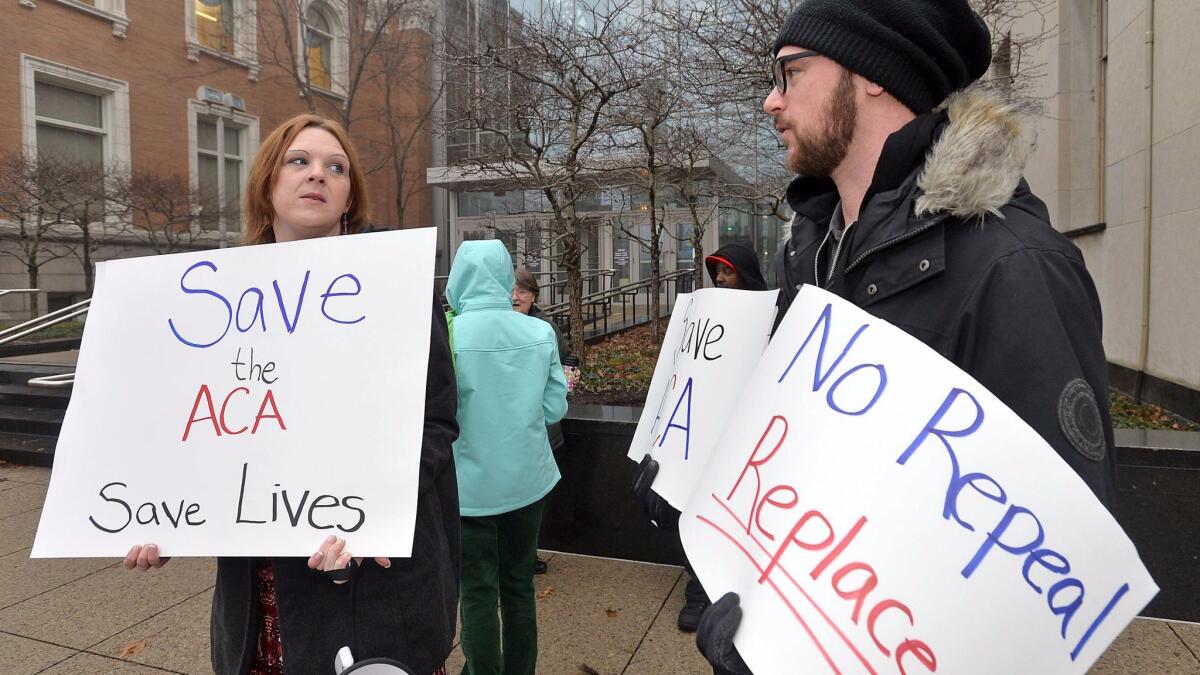Editorial: The hidden costs of replacing Obamacare

- Share via
Congressional Republicans set themselves on a fast track this month to repeal the tax and spending provisions of the 2010 Affordable Care Act. But President Trump and numerous GOP lawmakers are coming around to the view that it would be irresponsible, and possibly disastrous, to take that step without enacting a plan to replace the law at the same time.
That change of heart has forced opponents of the act to focus on something they should have been focusing on for years now: What is the problem they’re trying to fix? Because repealing Obamacare won’t slow rising healthcare costs by itself, and it certainly won’t enable more Americans to obtain health insurance.
The Trump administration and congressional Republicans are expected to release more specific proposals in the coming weeks, explaining how they plan to replace the health care reforms and subsidies in the ACA. (Trump also issued an executive order Friday instructing federal agencies to waive or delay any provision of the law that imposed a cost or burden on anyone, although it wasn’t at all clear how much discretion agencies have to do so.)
Obamacare has not been without its flaws. Critics of the ACA have complained of rising premiums and deductibles, smaller networks of doctors and hospitals, and fewer choices of insurance plans. But it’s important to remember that these problems only affect a small subset of the population. Most Americans get their health insurance through large employer plans that weren’t much affected by the healthcare law, and whose premium increases have been much smaller in recent years than they were before the recession.
It’s an open question whether newly liberated insurers would even offer coverage for some of the most expensive types of care.
The real target of the critics’ complaints is the much smaller market for individual health insurance plans — that is, policies for people not covered by their employers. Fewer than 22 million people bought such plans in 2015, representing only 7% to 8% of working-age adults with health insurance.
The ACA transformed this market, requiring insurers to offer comprehensive coverage to everyone who applied with no penalty for preexisting conditions (as insurers already had been doing in large employer-sponsored plans). People who were less healthy flocked to buy coverage, and the cost of covering them was spread out to everyone else who signed up for insurance in that market (and federal taxpayers, who subsidized many of the policies). Premiums rose modestly in some areas, quite sharply in others, and the number of insurers offering such plans dwindled. Never mind that almost half of these consumers were receiving subsidies that offset the increases; to critics, the rise in costs was proof that Obamacare was unsustainable.
Republicans have proposed to cut the cost of those policies without directly addressing the engine driving up insurance premiums, which is the cost of treating sick and injured Americans. Instead, the proposals floated by the GOP would eliminate the requirement that insurers offer only comprehensive policies, effectively removing the mechanism that spread costs and risks across the market.
As a result, insurers would be able to sell cheaper plans that excluded coverage of some costly treatments — maternity care, for example, or liver transplants. That would certainly cut premiums for healthier consumers, but it wouldn’t reduce the demand for pricey treatments. Instead, it will just push more of the cost of these procedures, drugs and devices onto the people who need them.
It’s an open question whether newly liberated insurers would even offer coverage for some of the most expensive types of care, especially if consumers were allowed to switch annually between cheap, minimal plans and more comprehensive ones as their needs changed. Anticipating this problem, the GOP proposals would create state-run “high risk pools,” a sort of insurer of last resort for consumers that private insurers shunned. Those pools have been tried in the past, and they proved so expensive for policyholders that states had to spend a small fortune subsidizing them. In other words, the move to high-risk pools would shift costs from people who buy insurance to taxpayers, which is a bit like passing the restaurant tab from your left hand to your right.
This might be a workable approach if it were sustainable, but what we’ve seen in the past isn’t encouraging. With premiums in their high-risk pools unaffordable and rising fast, states had trouble keeping up with the growing cost of the necessary subsidies. The answer in a number of them was to limit enrollment in the pools, leaving some people who badly needed care unable to find insurance.
People without insurance typically obtain less care, particularly routine treatment for less serious conditions. But that doesn’t necessarily yield large savings over the long run, because the uninsured tend to get care in the least efficient, most expensive way possible — in emergency rooms, when their conditions become too acute to ignore. Those costs, in turn, get passed on to paying customers of those hospitals and clinics, or rather, to those customers’ insurers and, potentially, the taxpayers.
The ACA wasn’t perfect, but it rightly recognized the need to do several things in tandem: control costs, expand coverage and improve the quality of care. Any alternative will have to address the same three issues; otherwise, it risks simply shifting the tab for the country’s rising demand for care from one of its pockets to another.
Follow the Opinion section on Twitter @latimesopinion and Facebook
More to Read
A cure for the common opinion
Get thought-provoking perspectives with our weekly newsletter.
You may occasionally receive promotional content from the Los Angeles Times.










